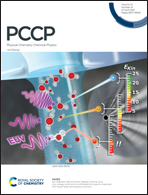Electronic structure of polypyrrole composited with a low percentage of graphene nanofiller†
Abstract
The low concentration of graphene (<5%) in graphene/polypyrrole composites makes it quite challenging to devise a theoretical model for these composites. Thus, herein, we present theoretical calculations to determine the geometric electronic and optical properties of graphene/polypyrrole composites. Ribbon and sheet models of various sizes were considered for graphene. Oligopyrrole of various lengths was deposited in the graphene model in different orientations including π-stacking, tilted and vertical orientations. Theoretical calculations at the M062X/def2-SVP level revealed that π-stacking is the preferred orientation. To model a lower concentration of graphene, sandwich complexes of oligopyrrole were considered with graphene nanoribbons. Interaction energies revealed that sandwich complexes possessed superior additivity. The NCI analysis established that weak van der Waals interactions existed in all composites. Moreover, the HOMO–LUMO gap decreases as the concentration of graphene increases. Thus, the computed optical band gap of the C58H24-based composite is about 1.7 eV, which is consistent with the reported experimental value (2.1–1.81 eV). The computed band gap further decreases to ∼1.6 eV when the proportion of graphene increases to C64H26. Thus, our results for the graphene nanoribbon-based polypyrrole composites are in good agreement with experimental results. The UV/visible spectra revealed that as the concentration of graphene increases, a red shift is observed for all the configurations, which is consistent with experimental results.



 Please wait while we load your content...
Please wait while we load your content...